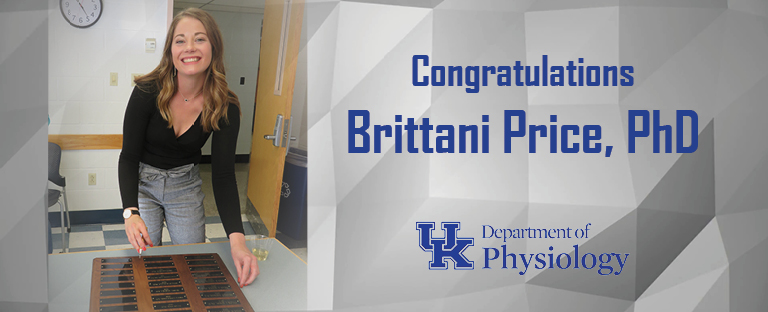Congratulations Brittani Price, PhD
On Monday, April 15, 2019 Brittani Price successfully defended her dissertation and earned her doctoral degree. Congratulations Dr. Price!
"Preclinical Targeting of TREM2 for the Treatment of Alzheimer’s disease-type Pathology in a Transgenic Mouse Model"
Abstract
Alzheimer’s disease (AD) is defined as a progressive neurodegenerative disorder and is characterized by a devastating mental decline. There are three pathological hallmarks of the disease necessary for its diagnosis, these are extracellular amyloid plaques comprised of beta-amyloid (Aβ) protein, intracellular neurofibrillary tangles comprised of hyperphosphorylated tau protein, and marked neuronal loss. Active immunization against Aβ1-42 or passive immunization with monoclonal anti-Aβ antibodies has been shown to reduce amyloid deposition and improve cognition in transgenic mouse models of AD, aged beagles, and nonhuman primates. Unfortunately, due to cerebrovascular adverse events, both active and passive immunization strategies targeting Aβ have failed in clinical trials. It is, therefore, necessary to identify novel amyloid-clearing therapeutics that do not induce cerebrovascular adverse events. We hypothesized that neuroinflammatory modulation could be a potential novel target.
Triggering receptor expressed on myeloid cells-2 (TREM2) is a lipid and lipoprotein binding receptor expressed exclusively in the brain by microglia. Homozygous TREM2 loss of function mutations cause early-onset progressive presenile dementia while heterozygous, function-reducing point mutations triple the risk of sporadic, late-onset AD. Heterozygous TREM2 point mutations, which reduce either ligand binding or cell surface expression, are associated with a reduction in the number of microglia surrounding amyloid plaques, microglial inability to phagocytose compact Aβ deposits and form a barrier between plaques and neurons, an increase in the number of phospho- tau-positive dystrophic neurites and increased tau in the cerebrospinal fluid. Heterozygous mutations also double the rate of brain atrophy and decrease the age of AD onset by 3-6 years. Although human genetics support the notion that loss of TREM2 function exacerbates neurodegeneration, it is unclear whether activation of TREM2 in a disease state is beneficial.
The work we present here characterizes a TREM2 agonizing antibody as a potential therapeutic for amyloid reduction. We found that its administration results in immune modulation, recruitment of microglia to the site of amyloid plaques, reduced amyloid deposition and improvement in spatial learning and novel object recognition memory in the 5xFAD model of AD. More specifically, we show that intracranial injection of TREM2 agonizing antibodies into the frontal cortex and hippocampus of 5xFAD mice leads to clearance of diffuse and compact amyloid. We also show that systemic injection of TREM2 agonizing antibodies weekly over a period of 14 weeks results in clearance of diffuse and compact amyloid as well as elevated plasma concentrations of Aβ1-40 and Aβ1-42.Furthermore, systemic administration of these antibodies led to immune modulation and enhanced cognitive performance on radial arm water maze and novel object recognition tests. Importantly, we show the TREM2 agonizing antibody does not induce the adverse cerebrovascular events known to accompany amyloid modifying therapies. Though systemic administration of both TREM2 agonizing and anti-Aβ antibodies does not further enhance amyloid clearance or cognitive performance, co-administration mitigates the adverse cerebrovascular events associated with anti-Aβ antibodies.
Collectively, these data indicate TREM2 activators may be an effective therapeutic target for the treatment of AD.
Acknowledgements
First and foremost, I’d like to thank all those that believed in and encouraged me along the way. I would not be here without your continued love and support.
Donna, I can’t even begin to thank you. Thank you for taking a chance on me, encouraging me, and challenging me. Thank you for allowing me to pursue everything I wanted to learn and accomplish, and for fueling me with caffeine, seltzer water, and wine as I did it. Above everything else, thank you for believing in me even when I didn’t believe in myself. I’ve said it before, and I’ll say it again: when I grow up, I want to be like you. If I am ever half the woman or half the scientist you are, I will consider both my life and career a success.
Tiffany, I’m at loss for words (which, as you know, rarely happens). I can’t begin to thank you for your patience while teaching me various techniques and answering my incessant questions. Thank you for accompanying me on countless trips to Speedway for diet coke and sour patch kids, for willingly wandering the streets of Dresden just so I could find a reasonably sized coffee, and for vouching to the Holland TSA agent that I am in no way a flight risk. You have become one of my very best friends and I couldn’t have made it this far without your encouragement. I owe you my sanity.
Erica, thank you for being such an excellent role model, for always sharing advice and feedback, and for teaching me to run RAWM (I think it’s safe to say which of those I’m least thankful for). Like Tiffany, you’ve become one of my best friends and I couldn’t have made it this far without you. But don’t worry, we both know I’ll be embarrassing you for years to come.
Lastly, a special thanks to the Department of Physiology and the members of my dissertation committee for continually challenging and encouraging me.
Doctoral Committee
Dr. Donna Wilcock, Department of Physiology , Mentor
Dr. Kathy Saatman, Department of Physiology
Dr. Steve Estus, Department of Physiology
Dr. Elizabeth Head, Department of Pharmacology and Nutritional Sciences
Dr. Peter Nelson, Department of Neuroscience
Outside Examiner
Dr. Christopher Norris, Department of Pharmacology and Nutritional Sciences
